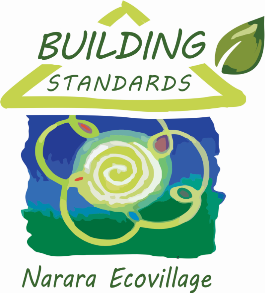The Narara Ecovillage Building Approval Pathway is shown in the diagram below. It is framed around a 3-Step process which is summarised below.

A significant test in building sustainable communities is how Lot Owners deal with their neighbours when placing and sizing their homes. The approval pathway sets down a requirement for Lot Owners to participate in a neighbourhood exchange as soon as possible in their home design. The aim of the exchange is to optimise the location of houses on lots to achieve equity across the neighbourhood in respect of solar access and overshadowing, and to consolidate at an early stage of the design consideration of both Hill Thalis and Central Coast Councils building setbacks and building envelopes and incorporation of common garden and services easements. The Building Review Panel’s recommendation with respect of access to sunlight is set out in Appendix 3 – Solar Access of these Building Standards. While the criteria are guidelines only and not mandatory they should inform each neighbourhood exchange. Ultimately the owner will be required to submit their design to the lot owners in their neighbourhood and obtain consent for their design. the neighbourhoods for stage 1 can be viewed at the link below The link also shows each lot owner their assigned Sustainable Design Appraiser (SDA). These are volunteers who have been trained in the villages Building standards and the assessment process. lot owners should work closely with their SDA throughout the design process. Stage 1 NeighbourhoodsNEV Neighbourhoods_V1-1.ppsx |
The objective of this step is to prepare all documents needed for the Lot Owner to tender their building works and to gain NEV’s building approval and Council’s development consent. NaTHERS and BASIX certificates are to be obtained by the Lot Owner at their cost as part of their design development. A list of NatHERS assessors located on the Central Coast is found online at NEV's Building Standards - NatHERS Assessors wiki page. Lot Owners also complete the Design Assessment Scoresheet and supporting questionnaire which consolidates the documentation needed to support the information provided in the scoresheet. The Sustainable Design Appraiser assigned to a Lot Owner will review and endorse the Lot Owner’s scoresheet and notify the BRP the design is ready for review and endorsement. The BRP will appoint 2 of its members to conduct independent reviews. they will compare results and recommend endorsement. The BRP will then contact the lot owners in the neighbourhood, share the design and ask for their consent. Finally when consent is obtained the BRP will electronically stamp the design drawings and the owner is now ready to submit their design for DA approval by Central Coast Council. |
When the Lot owner receives formal notification from council of their DA approval they should file copies of the approval letter and DA stamped plans into their Lot folder. They will then be ready to appoint a builder, obtain their construction certificate, an commence building. The BRP has developed 2 useful documents which outline the steps an owner needs to complete before building can commence and a second document which provides information to their builder on the forms and process they need to complete. You can find 2 very useful documents Building approvals - useful Reports and templates page.
|
Navigate to Other Pages
Download |
The editing permission for this page is controlled by Building Review panel (BRP). The page and its attachment is uncontrolled when printed or when saved on a personal electronic device.
View page history at this <Link>
